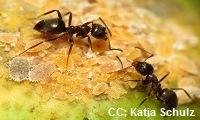Ecology and Environment
Habitats, life-cycles and the interactions between various species and their environments are covered in this series of hands-on activity ideas and supporting printable resources.
1. Evolutionary Spot the Difference discussion posters. Most suitable for ages 10+
A series of discussion posters that challenge participants to spot the differences between related groups of animals and plants and to think about why they are different and how evolution works. This resource could be used for a group activity in a school – challenge students to come up with some other examples!
Download: Discussion posters
2. Lifecycles. Most suitable for ages 5+
![]()
Flashcards featuring lifecycle stages of various animals and plants from sparklebox.co.uk
Why not print and laminate and use as an activity for younger children at family events? A more interactive butterfly cut and stick activity is available too.
Download life cycle cards: Butterfly | Frog | Ladybird | Sunflower
3. Invertebrates
a) Bug Zoom Game videos. Most suitable for ages 7+
This game involves visitors competing to guess what the image of an invertebrate is from a photo that is zoomed right in and that is made to slowly zoom out. Each competitor has a buzzer and they buzz in as soon as they think they can name the invertebrate. The person controlling the image stops the zooming out on each buzz and moves on to the next insect once one of the competitors has guessed correctly. Each image (courtesy of the Natural History Museum offers an opportunity to tell the competitors a couple of fun facts about the invertebrate - why not use this Fun Facts Sheet alongside the game?.
Download: Video files from our Dropbox
b) Make a Balloon Fly instructions, factsheet and images. Most suitable for ages 5+
![]()
This craft activity is a fun way to introduce the concept of mate attraction and nuptial gifts. Participants make their own Balloon Fly while also learning about how male flies produce silk balloons to offer as 'gifts' to approaching female flies described in the factsheet. This can be accompanied by images of these funny looking insects.
Download: Factsheet and Fly images & how to make instructions
c) Flying Ant factsheet (seasonal)
![]() Each summer swarms of flying ants suddenly appear around the UK. This happens when young queens leave the nest to start their own colony. This factsheet quickly introduces the topic of ants. We have worked with the University of Gloucestershire to conduct the Flying Ant Survey showing that ants fly on certain days in the summer all around the UK. Why not conduct your own local survey?
Each summer swarms of flying ants suddenly appear around the UK. This happens when young queens leave the nest to start their own colony. This factsheet quickly introduces the topic of ants. We have worked with the University of Gloucestershire to conduct the Flying Ant Survey showing that ants fly on certain days in the summer all around the UK. Why not conduct your own local survey?
Download: Flying ant factsheet
d) What's your favourite insect ballot. Most suitable for ages 5+

Find out more about our top 10 UK insects and read about the winner of the national poll. Print our posters, stick them around your school and host your own poll to see which creepy crawly comes out on top.
Download: Favourite insect posters
4. UK Fungus Day

UK Fungus Day is held in October each year
UK Fungus Day is an annual celebration of our fungal world, offering something for everyone. 2023 marks the 10th anniversary of UK Fungus Day. Alongside the many UK-based groups, museums, universities and research centres offering a chance to join fungus walks, view fungi collections and visit exhibitions of the latest fungal science and technology, UK Fungus Day invites everyone to join in, delve deeper and learn more about fungi through art and performance, crafts and creations, online talks, quizzes and competitions. Courtesy of the British Mycological Society.
Fungus life cycle poster
A poster to support fungi-related activities courtesy of the British Mycological Society.
Download: A4 poster
Make your favourite fungus
All you need is this poster and playdough or plasticine to create colourful fungi models.
Download: A4 poster
5. Plants. Most suitable for ages 3-11

Power plants activity
A creative task where participants can design their own garden by choosing a plants and sticking them on to the template. Information about the plants highlight how they can be beneficial to humans, animals and the environment. This task will get participants to think about what to include in their garden and the value of each plant. The information sheets also suggest useful features to add to the garden to increase wildlife. Use the poster as an example of a garden.


